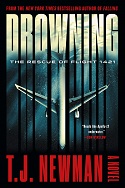 Synopsis:
Synopsis:
You just boarded a flight to New York.
There are one hundred and forty-three other passengers onboard.
What you don’t know: thirty minutes before the flight, the family of your pilot, Captain Bill Hoffman, was kidnapped.
The kidnapper has given him an ultimatum. He must choose between his family and the people onboard.
In order for Bill’s family to live, everyone on the plane must die.
The only way Bill’s family will survive is if the pilot follows orders and crashes the plane.
Enjoy the flight.
Review:

Debut author T.J. Newman’s route to success was circuitous. In 2006, she earned a degree in musical theater from Illinois Wesleyan University and attempted to establish herself as an actor in New York City, but was met with “abject failure.” She survived by babysitting, working in restaurants, and passing out fliers in Times Square before returning home to Phoenix and working at Changing Hands Bookstore, which propelled her back into the world of literature. Both her mother and sister worked as flight attendants, so she had knowledge of the airline industry. She first joined Virgin America in 2011, and later worked for Alaska Airlines, as a flight attendant, a job she loved.
When we log a flight plan, do you know why we write “souls on board” instead of “people on board”? We say it that way so that if we crash, they know exactly how many bodies they’re looking for. Avoids the confusion of different titles like passengers, crew, infants. Just how many bodies. That’s all they need to know.
During a red-eye flight, as Newman looked at the passengers, many of whom were sleeping, she really pondered the fact that passengers’ lives are in the pilot’s hands. For the first time, she thought about how the pilots have so much power and responsibility that they are vulnerable. She recalls asking a pilot, “‘What would you do if you find out that your family has been taken, and you’re told that if you don’t crash the plane, your family will be killed?’ Just based on the look on his face, I knew I had a story. He was terrified. He did not have an answer. There’s wasn’t a page in the manual for this.” She knew she would not be “able to rest until I knew the answer to that question.”
She began writing the book on “anything . . . scribbling it down,” largely on redeye flights when she had time. She would stand in the first-class galley and write, and she had, of course, colleagues readily available that she could ask specific questions about technical considerations. Several pilots read early drafts of the novel because once the door to the flight deck is closed and secured, flight attendants cannot see into the cockpit. So those pilots assisted by explaining protocols, the way that conversations really unfold, etc. Of course, some aspects are not revealed in the book because they must remain confidential in order to protect the public. Changes were also made for dramatic purposes.
Even after Newman completed over thirty drafts of the book, success did not immediately follow. She began querying agents and received forty-one rejections. Newman admits that rejections “sting,” but she knew she could not give up because “it only takes one ‘yes.'” The agent who finally said “yes” — lucky number forty-two — turned out to be “a perfect fit,” and helped her secure a publishing deal.
Newman’s characters were inspired by the crew members and passengers she encountered over the years. At the heart of the story is Captain Bill Hoffman, the pilot who accepts a flight from Los Angeles to New York because he could not refuse a request from the Chief Pilot. His wife, Carrie, is displeased because Bill promised to attend their ten-year-old son, Scott’s, baseball game and team pizza party. Things between them are tense, as Bill heads to the airport where he is happy to see that his friend, Jo, with whom he has flown for twenty years, is heading up the flight crew. She will be assisted by Michael Rodenburg, known to everyone at the airline as Big Daddy, and Kellie, a new flight attendant who has only recently completed her training. He’s also happy to find that Ben, with whom he has flown before, will be serving as his First Officer (co-pilot). Bill plans to speak with Carrie before his flight begins in an attempt to smooth things over and assuage his guilt about having left Carrie at home with Scott, Elise, their ten-month-old daughter, . . . and a technician from the local cable company dispatched to repair their internet connection.
Carrie offers the repairman a cup of tea, but turns to find him holding a gun. Shortly thereafter, once the plane is in the air, Bill receives an email on his laptop. There is no message. There is only a photo attached. Bill recognizes his living room, but Carrie and Scott have their arms outstretched in the shape of a cross and black hoods over their heads. Strapped across Carrie’s whole torso is a vest with brightly colored wires protruding from small bricks inside pockets. Bill immediately observes that it looks like the vests he has seen in photos of suicide bombers, but he can’t “process the sight of something so perverse strapped across his wife’s body.” Another email arrives that says, “Put on your headphones.” A FaceTime call is initiated, and Bill recognizes Sam, the purported cable technician, who is also wearing an explosive-laden vest and holding the detonator. Sam tells Bill, “You will crash your plane or I will kill your family. The choice is yours.” Bill knows his cockpit has been breached and the plane is in jeopardy. Bill’s response? “I’m not going to crash this plane and you’re not going to kill my family.”
Stories about kidnappings, airplane hijackings, and terrorist attacks are nothing new. But the way Newman has melded the concepts is new. She has cleverly combined the kidnapping of Bill’s family, the fact that Sam is not working alone, and the revelation that he and his accomplice intend for Bill to crash the plane at a specific location for clearly articulated reasons into one terrifying tale.
Newman’s characters are archetypical, but convincing because of her nuanced and multi-layered portrayal of their emotional battles. Bill is exactly the kind of pilot that every passenger wants to find in the cockpit of their flight. Competent, dedicated, and fully aware of the massive responsibility he shoulders every time he reports for work. He has never lost sight of what he learned in flight school at the age of just eighteen: why flight plans use the term “souls on board.” Right then he had to evaluate his prospects as a pilot. “Could he bear the burden of duty Could he be the man the job demanded?” He reminds himself as he performs the pre-flight checks that he has “souls on board” . . . and after the kidnapper’s demand is communicated to him, he is believably horrified that he is being asked to choose between the innocent souls entrusted to his care and his precious family. It is an impossible situation which is, of course, the kidnapper’s point. Sam also warns him not to involve the authorities or try to warn the flight crew, further complicating Bill’s predicament.
Carrie is a mother placed in a nightmare situation. It is her duty to protect her children. Little Elise is too young to comprehend the danger they are in, of course, but Scott is being traumatized before Carrie’s eyes. And, in his father’s absence, trying to be very brave. Carrie also knows her husband’s character and assures Sam that there is no way Bill will crash the plane. He will never choose Carrie and the children over all of the souls on board his flight. She tries to find an emotional connection with her captor, hoping that perhaps she can appeal to his humanity, at least where the lives of her children are concerned. But ultimately, all Carrie can do is remain as calm as possible, comfort the children, watch for an opportunity to take action herself . . . and have faith that Bill will figure out a solution. Because everything is at stake. He has to.
Jo, Big Daddy, and Kellie also play critical roles in the story. Jo is their leader and Newman convincingly portrays the events that unfold in the cabin from her perspective. As Newman explains, “Once the doors shut, that’s your cabin.” After 9/11, the design of cockpit doors and access procedures were revised. Now the pilot and copilot are literally locked in the cockpit behind a door that cannot be breached, leaving the flight crew on their own to manage whatever happens in the cabin. Jo has dealt with in-flight crises over the years, but nothing like the threat posed by Sam. And like Bill, she knows there is a strong likelihood that there is a co-conspirator onboard, ready to implement the kidnapper’s backup plan — whatever that might be — if Bill does not comply with Sam’s orders. But who might that be? A passenger? Or, worse, a member of the crew?
Newman says she is heartened by readers who relate that they had no idea, prior to reading Falling, about the vital functions of flight attendants “because you usually don’t see us doing our job. You see us serving you a drink, getting you a blanket . . . performing service duties.” Flight attendants undergo rigorous, weeks-long training, and they are actually on board to handle safety and security, and respond in case of passenger conflicts, medical emergencies, or mechanical issues. Making passengers comfortable is an incidental duty. “If I’m not doing my job as a flight attendant, that’s a good day. We don’t want to do our job because that means something has gone wrong,” Newman explains.
The book moves at a steady, relentless pace as Bill, Jo, and Jo’s nephew, Theo, an FBI agent whose career already hung in the balance before he learned about the drama unfolding on Flight 416, frantically work to out-smart Sam and his co-conspirator. Theo has to convince his superiors that Aunt Jo is indeed taking care of her cabin, but the threat must be taken seriously, which means involving officials at the highest levels of government and invoking protocols that leave no margin for error.
Newman’s narrative is tautly constructed and, because of her decade of experience in the airline industry, thoroughly, frighteningly believable. She explains why characters take particular actions and why protocols exist (with some dramatic license), enhancing reader’s comprehension of the threat. And the kidnapper’s motivation, once explained, is infuriating, shocking, and, with the benefit of hindsight, entirely predictable. Readers will find themselves feeling thankful that a similar, actual threat has never played out.
Falling is engrossing, entertaining, and a perfect choice for readers who enjoy fast-moving, plausible thrillers. It is a stunningly accomplished and polished effort from a first-time novelist, which bodes well for her next effort, the details of which she has not disclosed. Readers should set aside time to read because the book is un-put-down-able, which Newman finds gratifying. She says she is delighted when readers tell her they were unable to put the book down because they found it so enthralling and entertaining. “I’ve never been so happy to see so many sleep-deprived people,” she relates with a huge smile on her face.





Comments are closed.